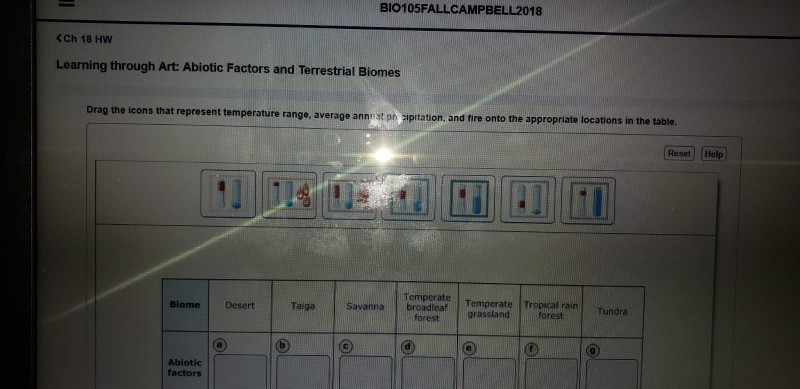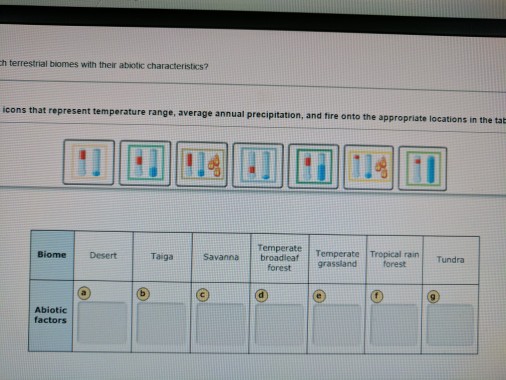Can You Match Terrestrial Biomes With Their Abiotic Characteristics
Aquatic biomes include both. Summers are short and moist.
Introduces the group of land-based ecosystems such as tropical rainforests temperate grasslands and tundras.

. Physical factors or conditions that influence plant and animal life. This indicates how strong in your memory this concept is. There are various types of biomes the exact number of biomes in this world is still not known and keep on varying.
Summers are hot winters are cold moderate rainfall fires possible 3. Winters are cool and wet. Humid all year hot and wet 2.
Identifies how terrestial biomes can be classified. They are tundra taiga desert tropical grassland or savanna temperate grassland temperate forest and tropical rain forest. Approximately 170000 of the 250000 described species of vascular plants occur in.
Terrestrial Biomes - Abiotic factors. In the areas with little rainfall plants have adapted to drought-like conditions. Two factors which determine which biome is present is the animal and plant species and climate.
Cold and dark much of the year 6. Think About It Sample. Well defined 4 seasons rich soil.
This article addresses the climate and biodiversity of one of Earths most diverse and iconic biomes. These are further subdivided in to more specific biomes. You do not need to memorize a list of Earths major terrestrial biomes and their descriptive features.
The shrublands are made up of shrubs or short trees. Major Biomes of the world. Annual totals and fluctuations of precipitation affect the kinds of vegetation and animal life that can exist in broad.
Biomes are large-scale environments that are distinguished by characteristic temperature ranges and amounts of precipitation. Active Reading 9 IdentifyUnderline the abiotic features that characterize tundra and taiga biomes. Shrublands are usually fairly open so grasses and other short plants grow between the shrubs.
Your mission should you choose to accept it is to investigate biomes then test your knowledge about the biomes by completing each mission. Winters are long cold and dry 4. Up to 24 cash back What are the major terrestrial biomes.
There are seven major terrestrial biomes. A biome is a community of plants and animals living together in a certain kind of climate. Tropical rainforests savannas subtropical deserts chaparral temperate grasslands temperate forests boreal forests and Arctic tundra.
Terrestrial biomes are based on land while aquatic biomes include both ocean and freshwater biomes. There are five major types of biomes. These two variables affect the types of vegetation and animal life.
From one biome to another provides clues as to the importance of abiotic factors in the distribution of biomes. Short mild summers long cold dry winters acidic nutrient poor soil. A biome is a large area characterized by its vegetation soil climate and wildlife.
Area of the planet which can be classified according to the plant and animal life in it. Covers characteristics and classifications of biomes. Aquatic biomes which are water-based such as ponds and lakes.
Aquatic grassland forest desert and tundra though some of these biomes can be further divided into more specific categories such as freshwater marine savanna tropical rainforest temperate rainforest and taiga. The eight major terrestrial biomes on Earth are each distinguished by characteristic temperatures and amount of precipitation. Terrestrial biomes which are land-based such as deserts and forests.
Groups of similar ecosystems with the same general abiotic factor and primary producers. Temperature Woodland and shrubland. Marine Freshwater Dessert Grasslands Forests and Tundra Deserts.
1 because students are comparing two different biomes with respect to their shared characteristics. Very high annual rainfall high average temperatures nutrient-poor soil and high levels of biodiversity species richness. There are eight major terrestrial biomes.
The abiotic factors such as the amount of rainfall and the temperature are going to influence other abiotic factors such as the quality of the soil. There is usually not enough rain to support tall trees. Desert biomes can be classified according to several characteristics.
This indicates how strong in your memory this concept is. Up to 24 cash back The grasslands have many unique abiotic and biotic factors. Match the abiotic factors to their biomes Abiotic factors 1.
Scientists have classified regions of the world into different biomes. No matter where they occur on the planet biomes have similar types of vegetation and animal life or ecological communities. Land covered by evergreen trees in cool northern latitudes.
Based on the certain similarities and to make the classification simpler the biomes are main groups according to the predominant. The tropical forest biome is estimated to contain over half of the terrestrial species on Earth. Summers are very hot and dry.
Many shrubs thrive on steep rocky slopes. Biotic factors are the living organsims in a biome such as monkeys snakes and ferns. The tropical rainforest biome has four main characteristics.
Abiotic factors are factors that arent a live such as rain rocks and sand. The Terrestrial Biomes section is importantread it carefully paying attention to the section Exploring Terrestrial Biomes and keeping in mind that we will return to this subject in more detail in. On a very high point of a tundra trees can not survive because of the low oxygen level due to the hight altitude.
Non-living factors such as elevation humidity and soil type. In this biome the biggest factors is the very high altitude temperature and weathers. Biomes are regions of Earth that have similar climates and other abiotic.
We will focus on the terrestrial or land biomes of North America because that is where we live. Strong winds short soggy summers cold dark much of year permafrost. On this page you will learn about all the factors that make our biome different and diverse from others.
While coastal zones are included in the Critical Zone most of the section on oceanic biomes is irrelevant to this course and you can skip it. The biomes include- desserts different types of forest polar regions national parks bird sanctuaries zoos aquatic life and a lot more. Having to do with living or once-living organisms.

Bio105fallcampbell2018 Ch 18 Hw Learning Through Art Chegg Com



No comments for "Can You Match Terrestrial Biomes With Their Abiotic Characteristics"
Post a Comment